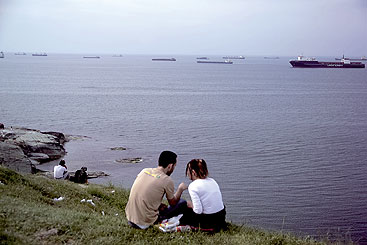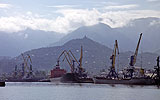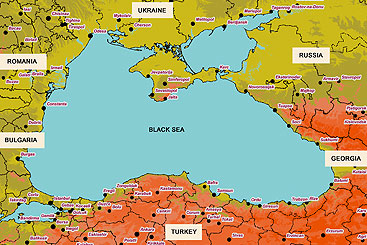
Recovery is on the horizon for the Black Sea
For a sea almost completely cut off from the world’s oceans, the Black Sea is proving that cooperation and joint efforts are the key to reversing ecological damage and to promoting change.

Recently there have been positive signs of Black Sea recovery. Phytoplankton blooms tend to be less severe than during the 1980s and include a wider variety of species, and biodiversity is continuing to improve close to where the Danube enters the sea.
The Black Sea is the most isolated sea in the world; its only connection to other marine water bodies is through the winding Bosphorus Straits. For this reason, the Black Sea is very vulnerable to pressure from land-based human activity and its health is dependent on cooperation in the region.
The Black Sea covers 423,000 km² and is over 2 km deep at its deepest point. Every year, 350 km³ of river water pour into the Black Sea draining a 2 million km² basin – almost a third of continental Europe. The area influences significant areas of 17 countries containing over 160 million inhabitants. Bulgaria, Georgia, Romania, Russia, Turkey and Ukraine all border the Black Sea.
Success through cooperation. Now in its final stage, The Black Sea Ecosystem Recovery Project (BSERP) has broad aims concerning most aspects of marine environmental management. The project has worked in close cooperation with the Black Sea Commission (BSC) to provide technical and financial support for policy and legislation development. The project has supported capacity building of environmental monitoring and scientific institutions within the six countries through development of standardised regional monitoring methodologies, pilot monitoring exercises, research cruises, river and point source load assessments, modelling and atmospheric deposition studies.
“We have seen many UN organisations involved in cooperation on the Black Sea,” says Ulrika Richardson- Golinsky, UNDP Deputy Resident Representative in Turkey, “which cuts across boundaries and brings people together.”
The BSERP has promoted closer cooperation between the ICPDR and the BSC. On a formal level, staff from both the BSERP and the Danube Regional Project (DRP), as well as the ICPDR and BSC Secretariats, have been members of the Danube-Black Sea Joint Technical Working Group. This cooperation created the first report on ‘Danube Impact on the Black Sea’, and a recent brochure on nutrient management within the Danube/Black Sea Basin.
However, it is the informal links between the BSERP unit in Istanbul, the DRP in Vienna and the staff of the two commissions that have created the greatest benefits in terms of the flow of information. “Success in the Black Sea shows the importance of cooperation between regional actors, countries and the governments,” says Jose Rizo Martin, European Commission, DG Environment.
Guiding policy and action. The BSERP’s work has brought changes in legislation and policy, including the draft of an updated Land-Based Sources and Activities Protocol, development of a regional stockassessment methodology for turbot populations, technical annexes to the existing Protocol on Conservation of Biological Diversity and the Contingency Plan annexed to the Protocol on Cooperation in Combating Pollution by Oil and other Harmful Substances in Emergency Situations.
Legal and institutional reviews of the Black Sea Commission and a Project Exit Strategy have also been completed, as well as a Feasibility Study on Integrated Coastal Zone Management, to recommend options for the future regional development of this policy. A further document on cost-benefit analysis of nutrient emission control options was recently delivered to the BSC, with the intention that this could influence policy development in future years.
Updating the 1996 ‘Black Sea Transboundary Diagnostic, led to a technical draft of an update of the Black Sea Strategic Action Programme. Once completed, this document will be signed by all six countries at a Ministerial Conference in Ukraine later this year.
 There has been a substantial boost to promote good
environmental monitoring
in the Black Sea, with
large amounts of money
spent to assess environmental
status.
There has been a substantial boost to promote good
environmental monitoring
in the Black Sea, with
large amounts of money
spent to assess environmental
status.Status of the Black Sea – past and present. Beginning in the 1970s and continuing through to the early 1990s, excessive nutrient pollution led to the development of intense phytoplankton blooms dominated by a single species. Large-scale eutrophication and the depletion of oxygen caused mass mortalities of animal life within huge areas of the northwest shelf. This reached a peak in 1990 when some 40,000 km² – or 80% – of the northwest shelf bed was considered to be effectively dead.
There is no doubt that the Danube has a significant impact on the ecology of the Black Sea. The ecological effects of the Danube can most clearly be seen on bottom- living fauna, with immediate impacts closest to where the Danube enters the sea, and the severity of those impacts reducing with increasing distance from the Danube Delta. Of course, this is also due to impacts from the northern Dniester Liman.
Recently there have been positive signs of Black Sea recovery. Phytoplankton blooms tend to be less severe than during the 1980s and include a wider variety of species, and biodiversity is continuing to improve close to where the Danube enters the sea.
So the impact, while still serious, is decreasing. Earlier reductions in wastewater pollution from the upstream countries and the economic slowdown in the former communist countries were major contributors. However, the BSERP and the Danube countries can also take credit for their numerous joint efforts. “The ultimate criterion of success of the project”, says Violeta Velikova, Pollution Monitoring and Assessment Officer at the Secretariat of the Black Sea Commission “is the Sea itself.”
Future steps. With the phase-out of funding from the project, the BSC must review its funding sources, increase in-country contributions and reassess its priorities. The BSC now has a robust technical and legislative basis from which to work, but there is still a considerable effort required. Negotiations on the Black Sea Strategic Action Plan (SAP) need to focus on the main outstanding issues and causes, and prioritise them.
Mobilised concerted efforts of UN organisations, European Union, other donors and the Black Sea countries have been critical for the restoration of the Black Sea ecosystem. There has been a substantial boost to promote good environmental monitoring, with large amounts of money spent to assess environmental status. This has provided the BSC and the six coastal countries with a good start, but this momentum needs to be maintained through the SAP.
As a result of the work of the last five years, the BSC is in an excellent position to take up the challenges ahead. As the BSERP comes to a close, there are many achievements to celebrate and much has been improved. Perhaps the greatest achievement is in proving that the most isolated sea geographically is not isolated in spirit as cooperation continues to bloom.
For more
information, please visit: www.bserp.org,
www.undp-drp.org or www.blacksea-commission.org.

THE BLACK SEA ECOSYSTEM RECOVERY PROJECT
The Black Sea Ecosystem Recovery Project (BSERP) – as well as the Danube Regional Project – was developed under the Global Environmental Facility (GEF) and was implemented by the United Nations Development Programme (UNDP). The project, with a budget of $10.5 million, builds on a series of GEF International Waters (IW) projects for the Black Sea that together represent one of the most extensive and consistent interventions in the GEF IW portfolio.
Public Participation
An important feature of the BSERP has been its encouragement of broad stakeholder participation, through small grant programmes as well as the organisation and funding of national and regional programmes for the celebration of Black Sea Day. Further work spread the message of the region’s problems through the production of a documentary, ‘The Sea that Nearly Died’, shown on BBC World as part of the Earth Report Series.
Research and information exchange
Four research cruises have been organised on the northwest shelf where the Danube enters the Black Sea. Data gathered from these cruises, combined with long-term routine monitoring results, provide an excellent overview of the ecological changes that have occurred and the current status of this fundamentally important area of the sea.
Agriculture
Agriculture is the most important sector to tackle to prevent a return to the ‘bad old days’ of lifeless seabeds, with particular attention focused on livestock waste disposal and recycling as organic fertiliser. Considerable investments and improvements have occurred in some Black Sea countries, but there is a need to persuade other countries to follow suit. However, this is very difficult for politicians to grasp, bearing in mind the regional decline in agriculture. On average over a ten year period, the contribution of agriculture to Black Sea country gross domestic product (GDP) fell by about a half.
Disclaimer
The information contained in the ICPDR website is intended to enhance public access to information about the ICPDR and the Danube River. The information is correct to the best of the knowledge of the ICPDR Secretariat. If errors are brought to our attention we will try to correct them.
The ICPDR, expert group members, nor other parties involved in preparation of information contained on this website cannot, however, be held responsible for the correctness and validity of the data and information provided, nor accept responsibility or liability for damages or losses arising directly or indirectly from the use of the information conveyed therein.
Only those documents clearly marked ICPDR documents reflect the position of the ICPDR.
Any links to other websites are provided for your convenience only. The ICPDR does not accept any responsibility for the accuracy, availability, or appropriateness to the user's purposes, of any information or services on any other website.
When using the information and material provided on this website, credit should be given to the ICPDR.
